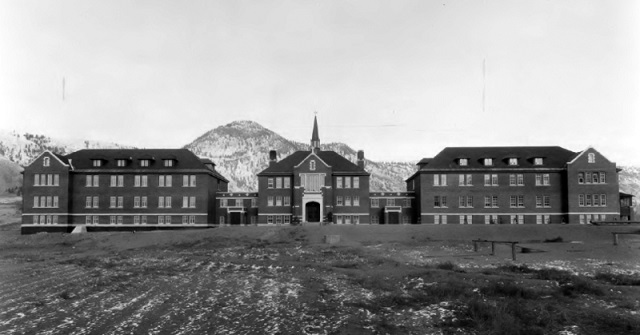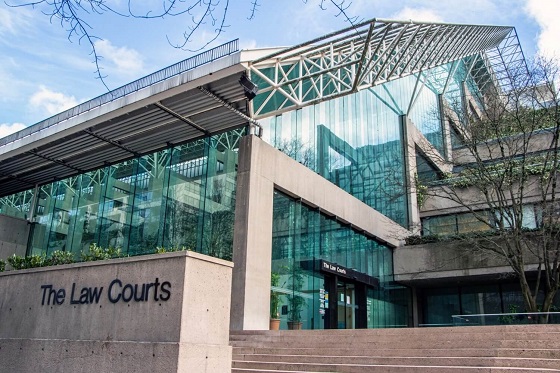Frontier Centre for Public Policy
A letter to five Canadian Churches

From the Frontier Centre for Public Policy
Two years ago, Eric Metaxas, the conservative Christian American author wrote a short, but important, book addressing the American Church. He was concerned the churches were forsaking their Christian principles in not speaking out against the anti-Christian ideologies and practices occurring throughout the U.S.
My letter is limited to admonishing the Canadian churches involved with Canada’s Indian Residential Schools. These churches have not spoken out in support of the missionaries they commissioned to work in these schools, people who poured their lives into their work, and who have been wrongly accused of abusing and murdering residential school children.
Obviously, those employees who are guilty should be condemned and punished, but those who are innocent should not be falsely accused of perpetrating horrific crimes.
Between 1883 and 1996, there were 143 Indian Residential Schools included in the Indian Residential Schools Settlement Agreement, a complex agreement between various Indigenous groups, the federal government, and the churches that managed residential schools.
The Roman Catholic Church managed 62 (43.4%) of the schools, the Church of England (Anglican) managed 35 (24.5%), the United Church (including the denominations that joined together in 1925) managed 19 (13.3%), the Mennonite Church managed 3 (2.1%), and the Baptist Church managed 1 (0.6%) residential school. The federal and territorial governments managed the remaining 23 (16.1%) schools.
There are four historical points to be reviewed.
First, in May 2021, Rosanne Casimer, Chief of the Kamloops Band, announced that ground penetrating radar (GPR) had found 215 unmarked graves of children in the residential schoolyard.
Surprisingly, this was the first public report suggesting that children buried in residential schoolyards had been murdered. There is, however, no credible evidence of murdered residential school children in the 3,500-page Truth and Reconciliation Commission (TRC) Report which was published 6 years earlier.
Second, despite being absent from the TRC’s “Calls to Action,” the federal government has awarded almost $8 million to the Kamloops band to excavate part of the schoolyard, and set aside over $300 million for other bands to search for soil anomalies or presumed graves.
Third, as expected with such strong incentives, many other bands have claimed that they too have graves of missing and presumed murdered children buried in the schoolyards on their reserves.
Finally, in an impressive gesture of support, Prime Minister Justin Trudeau knelt beside a grave in a well-known cemetery with a teddy bear in his hand decrying the genocide perpetrated by the churches. Later, he had the Canadian flags at government buildings around the world flown at half-mast for 6 months so that both Canadians and citizens of the world would mourn this Canadian tragedy.
Since the spring of 2021, almost 100 Christian churches have been vandalized, desecrated, or set on fire, supposedly because of the “genocide” that had taken place at the sites of Indian Residential Schools. Sadly, some of these churches, the Lutheran and Orthodox churches, for example, did not manage any of the schools.
No doubt, most Canadians are thankful there is no forensic evidence that children have been murdered and buried in schoolyards. Of course, there are children’s bodies in parish cemeteries that are often close to the schools, but most of them died of communicable diseases like influenza and TB, and they have been given proper funerals.
My concern is that over the last three years, the five churches that managed Indian Residential Schools have said little or nothing to defend themselves or the staff they commissioned to work in the schools.
In a time of need, both Indigenous and non-Indigenous Christians stepped forward to care for children living in residential schools. But the churches have not stepped forward to defend their staff in their time of need. These people are getting old, and they need support now. Instead, the churches have abandoned, or worse, condemned their faithful employees for abusing children.
Equally surprising, no church leader has supported the fundamental principle of Canadian law: individuals (and churches) are considered innocent until they are proven guilty.
It grieves me, and the few other living residential school employees, that our churches have not publically supported their innocent employees. Surely, they have a moral obligation to ensure that truth and justice prevail.
Eric Metaxas has tried to awaken American churches by pointing out where they have gone wrong. Should we not try to awaken Canadian churches to defend their involvement in Indian residential schools?
Is it too much to suggest that the church leaders think back to lessons learned from Martin Luther King Jr. and Dietrich Bonhoeffer who stood up for Christian principles against the evil practice of dehumanizing people—Blacks in the U.S. and Jews in Europe?
Not only will these churches be judged by the moral and ethical lessons they preach, but, more importantly, by the principles they live by. Canadians will see the true values of church leaders in their actions, especially concerning those they commissioned to work in their schools.
Rodney A. Clifton lived for 4 months in Old Sun, the Anglican residential school on the Siksika (Blackfoot) First Nation during the summer of 1966, and he was the Senior Boys’ Supervisor in Stringer Hall, the Anglican residential hostel in Inuvik during the 1966-67 school year. He is a Professor Emeritus at the University of Manitoba and a senior fellow at the Frontier Centre for Public Policy. His most recent book, with Mark DeWolf, is From Truth Comes Reconciliation: An Assessment of the Truth and Reconciliation Commission Report. The book will be out on November 5, and it can be preordered from the publisher.
Rodney A. Clifton is a professor emeritus at the University of Manitoba and a Senior Fellow at the Frontier Centre for Public Policy. He lived for four months in Old Sun, the Anglican Residential School on the Blackfoot (Siksika) First Nation, and was the Senior Boys’ Supervisor in Stringer Hall, the Anglican residence in Inuvik. Rodney Clifton and Mark DeWolf are the editors of From Truth Comes Reconciliation: An Assessment of the Truth and Reconciliation Commission Report (Frontier Centre for Public Policy, 2021). A second and expanded edition of this book will be published in early 2024.
Business
Ottawa Is Still Dodging The China Interference Threat

From the Frontier Centre for Public Policy
By Lee Harding
Alarming claims out of P.E.I. point to deep foreign interference, and the federal government keeps stalling. Why?
Explosive new allegations of Chinese interference in Prince Edward Island show Canada’s institutions may already be compromised and Ottawa has been slow to respond.
The revelations came out in August in a book entitled “Canada Under Siege: How PEI Became a Forward Operating Base for the Chinese Communist Party.” It was co-authored by former national director of the RCMP’s proceeds of crime program Garry Clement, who conducted an investigation with CSIS intelligence officer Michel Juneau-Katsuya.
In a press conference in Ottawa on Oct. 8, Clement referred to millions of dollars in cash transactions, suspicious land transfers and a network of corporations that resembled organized crime structures. Taken together, these details point to a vulnerability in Canada’s immigration and financial systems that appears far deeper than most Canadians have been told.
P.E.I.’s Provincial Nominee Program allows provinces to recommend immigrants for permanent residence based on local economic needs. It seems the program was exploited by wealthy applicants linked to Beijing to gain permanent residence in exchange for investments that often never materialized. It was all part of “money laundering, corruption, and elite capture at the highest levels.”
Hundreds of thousands of dollars came in crisp hundred-dollar bills on given weekends, amounting to millions over time. A monastery called Blessed Wisdom had set up a network of “corporations, land transfers, land flips, and citizens being paid under the table, cash for residences and property,” as was often done by organized crime.
Clement even called the Chinese government “the largest transnational organized crime group in the history of the world.” If true, the allegation raises an obvious question: how much of this activity has gone unnoticed or unchallenged by Canadian authorities, and why?
Dean Baxendale, CEO of the China Democracy Fund and Optimum Publishing International, published the book after five years of investigations.
“We followed the money, we followed the networks, and we followed the silence,” Baxendale said. “What we found were clear signs of elite capture, failed oversight and infiltration of Canadian institutions and political parties at the municipal, provincial and federal levels by actors aligned with the Chinese Communist Party’s United Front Work Department, the Ministry of State Security. In some cases, political donations have come from members of organized crime groups in our country and have certainly influenced political decision making over the years.”
For readers unfamiliar with them, the United Front Work Department is a Chinese Communist Party organization responsible for influence operations abroad, while the Ministry of State Security is China’s main civilian intelligence agency. Their involvement underscores the gravity of the allegations.
It is a troubling picture. Perhaps the reason Canada seems less and less like a democracy is that it has been compromised by foreign actors. And that same compromise appears to be hindering concrete actions in response.
One example Baxendale highlighted involved a PEI hotel. “We explore how a PEI hotel housed over 500 Chinese nationals, all allegedly trying to reclaim their $25,000 residency deposits, but who used a single hotel as their home address. The owner was charged by the CBSA, only to have the trial shut down by the federal government itself,” he said. The case became a key test of whether Canadian authorities were willing to pursue foreign interference through the courts.
The press conference came 476 days after Bill C-70 was passed to address foreign interference. The bill included the creation of Canada’s first foreign agent registry. Former MP Kevin Vuong rightly asked why the registry had not been authorized by cabinet. The delay raises doubts about Ottawa’s willingness to confront the problem directly.
“Why? What’s the reason for the delay?” Vuong asked.
Macdonald-Laurier Institute foreign policy director Christopher Coates called the revelations “beyond concerning” and warned, “The failures to adequately address our national security challenges threaten Canada’s relations with allies, impacting economic security and national prosperity.”
Former solicitor general of Canada and Prince Edward Island MP Wayne Easter called for a national inquiry into Beijing’s interference operations.
“There’s only one real way to get to the bottom of what is happening, and that would be a federal public inquiry,” Easter said. “We need a federal public inquiry that can subpoena witnesses, can trace bank accounts, can bring in people internationally, to get to the bottom of this issue.”
Baxendale called for “transparency, national scrutiny, and most of all for Canadians to wake up to the subtle siege under way.” This includes implementing a foreign influence transparency commissioner and a federal registry of beneficial owners.
If corruption runs as deeply as alleged, who will have the political will to properly respond? It will take more whistleblowers, changes in government and an insistent public to bring accountability. Without sustained pressure, the system that allowed these failures may also prevent their correction.
Lee Harding is a research fellow for the Frontier Centre for Public Policy.
Frontier Centre for Public Policy
Tent Cities Were Rare Five Years Ago. Now They’re Everywhere

From the Frontier Centre for Public Policy
Canada’s homelessness crisis has intensified dramatically, with about 60,000 people homeless this Christmas and chronic homelessness becoming entrenched as shelters overflow and encampments spread. Policy failures in immigration, housing, monetary policy, shelters, harm reduction, and Indigenous governance have driven the crisis. Only reversing these policies can meaningfully address it.
Encampments that were meant to be temporary have become a permanent feature in our communities
As Canadians settle in for the holiday season, 60,000 people across this country will spend Christmas night in a tent, a doorway, or a shelter bed intended to be temporary. Some will have been there for months, perhaps years. The number has quadrupled in six years.
In October 2024, enumerators in 74 Canadian communities conducted the most comprehensive count of homelessness this country has attempted. They found 17,088 people sleeping without shelter on a single autumn night, and 4,982 of them living in encampments. The count excluded Quebec entirely. The real number is certainly higher.
In Ontario alone, homelessness increased 51 per cent between 2016 and 2024. Chronic homelessness has tripled. For the first time, more than half of all homelessness in that province is chronic. People are no longer moving through the system. They are becoming permanent fixtures within it.
Toronto’s homeless population more than doubled between April 2021 and October 2024, from 7,300 to 15,418. Tents now appear in places that were never seen a decade ago. The city has 9,594 people using its shelter system on any given night, yet 158 are turned away each evening because no beds are available.
Calgary recorded 436 homeless deaths in 2023, nearly double the previous year. The Ontario report projects that without significant policy changes, between 165,000 and 294,000 people could experience homelessness annually in that province alone by 2035.
The federal government announced in September 2024 that it would allocate $250 million over two years to address encampments. Ontario received $88 million for ten municipalities. The Association of Municipalities of Ontario calculated that ending chronic homelessness in their province would require $11 billion over ten years. The federal contribution represents less than one per cent of what is needed.
Yet the same federal government found $50 billion for automotive subsidies and battery plants. They borrow tonnes of money to help foreign car manufacturers with EVs, while tens of thousands are homeless. But money alone does not solve problems. Pouring billions into a bureaucratic system that has failed spectacularly without addressing the policies that created the crisis would be useless.
Five years ago, tent cities were virtually unknown in most Canadian communities. Recent policy choices fuelled it, and different choices can help unmake it.
Start with immigration policy. The federal government increased annual targets to over 500,000 without ensuring housing capacity existed. Between 2021 and 2024, refugees and asylum seekers experiencing chronic homelessness increased by 475 per cent. These are people invited to Canada under federal policy, then abandoned to municipal shelter systems already at capacity.
Then there is monetary policy. Pandemic spending drove inflation, which made housing unaffordable. Housing supply remains constrained by policy. Development charges, zoning restrictions, and approval processes spanning years prevent construction at the required scale. Municipal governments layer fees onto new developments, making projects uneconomical.
Shelter policy itself has become counterproductive. The average shelter stay increased from 39 days in 2015 to 56 days in 2022. There are no time limits, no requirements, no expectations. Meanwhile, restrictive rules around curfews, visitors, and pets drive 85 per cent of homeless people to avoid shelters entirely, preferring tents to institutional control.
The expansion of harm reduction programs has substituted enabling for treatment. Safe supply initiatives provide drugs to addicts without requiring participation in recovery programs. Sixty-one per cent cite substance use issues, yet the policy response is to make drug use safer rather than to make sobriety achievable. Treatment programs with accountability would serve dignity far better than an endless supply of free drugs.
Indigenous people account for 44.6 per cent of those experiencing chronic homelessness in Northern Ontario despite comprising less than three per cent of the general population. This overrepresentation is exacerbated by policies that fail to recognize Indigenous governance and self-determination as essential. Billions allocated to Indigenous communities are never scrutinized.
The question Canadians might ask this winter is whether charity can substitute for competent policy. The answer is empirically clear: it cannot. What is required before any meaningful solutions is a reversal of the policies that broke it.
Marco Navarro-Genie is vice-president of research at the Frontier Centre for Public Policy and co-author with Barry Cooper of Canada’s COVID: The Story of a Pandemic Moral Panic (2023).
-

 Business2 days ago
Business2 days agoLand use will be British Columbia’s biggest issue in 2026
-

 Digital ID1 day ago
Digital ID1 day agoThe Global Push for Government Mandated Digital IDs And Why You Should Worry
-

 Business1 day ago
Business1 day agoFeds pull the plug on small business grants to Minnesota after massive fraud reports
-

 Business20 hours ago
Business20 hours agoDOOR TO DOOR: Feds descend on Minneapolis day cares tied to massive fraud
-

 Bruce Dowbiggin20 hours ago
Bruce Dowbiggin20 hours agoIn Contentious Canada Reality Is Still Six Degrees Of Hockey
-

 Business19 hours ago
Business19 hours agoCanada needs serious tax cuts in 2026
-

 Energy2 days ago
Energy2 days agoWhy Japan wants Western Canadian LNG
-

 Business9 hours ago
Business9 hours agoOttawa Is Still Dodging The China Interference Threat









